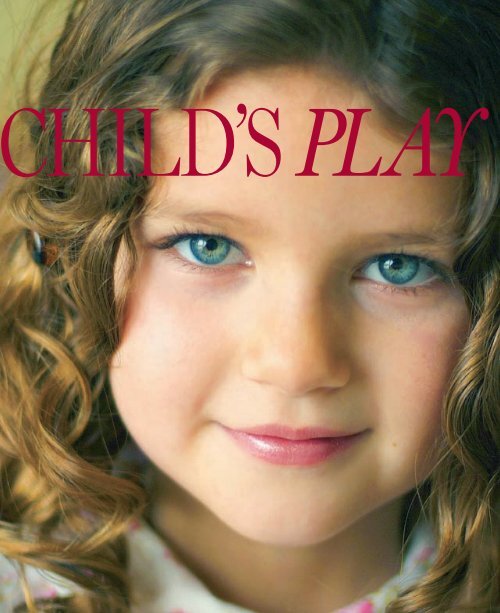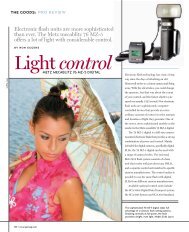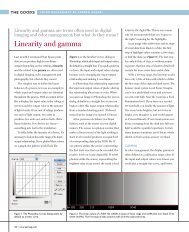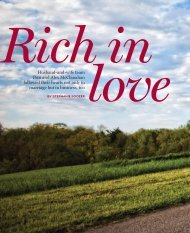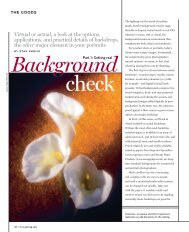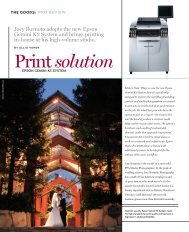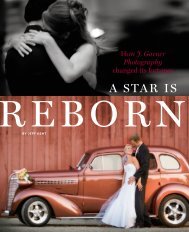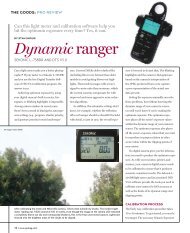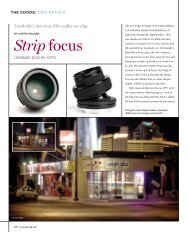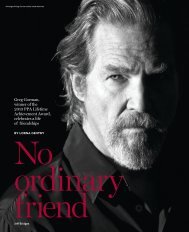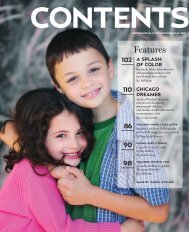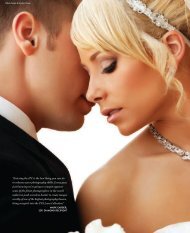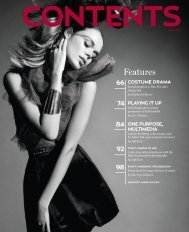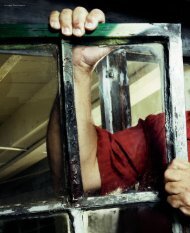Audrey Woulard - Professional Photographer Magazine
Audrey Woulard - Professional Photographer Magazine
Audrey Woulard - Professional Photographer Magazine
You also want an ePaper? Increase the reach of your titles
YUMPU automatically turns print PDFs into web optimized ePapers that Google loves.
HILD’S PLAY
<strong>Audrey</strong><br />
<strong>Woulard</strong><br />
photographs<br />
children<br />
au naturel<br />
BY LORNA GENTRY<br />
All images ©<strong>Audrey</strong> <strong>Woulard</strong>
espite being stuck in rush-hour<br />
traffic on an unsually warm<br />
autumn afternoon in Chicago,<br />
<strong>Audrey</strong> <strong>Woulard</strong> is upbeat and talkative. As she<br />
wends her way home to the suburbs from her<br />
downtown studio loft, <strong>Woulard</strong> is energized, even<br />
though she’s been shooting all day. Not<br />
much seems to faze her. Not traffic. Not<br />
babies urinating on her. Not even balancing<br />
motherhood—she has four boys aged five to<br />
15—with a weekly average of 35 photo<br />
sessions in studio and on location.<br />
Success came quickly to <strong>Woulard</strong>, who<br />
had been a professional photographer just a<br />
couple of years when a guide for new moms,<br />
“City Baby Chicago,” anointed her one of the<br />
city’s top children’s photographers in 2004.<br />
Early this year she acquired an agent to<br />
handle her editorial work, which sharply<br />
increased after a catalog assignment for<br />
Pottery Barn Kids.<br />
Her work has also appeared in InStyle<br />
magazine, Better Homes and Gardens magazine,<br />
the Chicago Sun Times newspaper, and<br />
on CBS news. She was chosen to be one of<br />
14 photographers nationwide featured in the<br />
2007 book, “<strong>Professional</strong> Children’s Portrait<br />
Photography: Techniques and Images from<br />
Master <strong>Photographer</strong>s” (Amherst Media).<br />
Three years ago she stopped marketing<br />
altogether. Word of mouth and repeat<br />
customers keep volume high.<br />
All this was unexpected. Born in<br />
Winfiled, Ill., a village about 30 miles west<br />
of Chicago, <strong>Woulard</strong> earned a degree in<br />
computer science at the University of<br />
Illinois. As her children were born, she<br />
faced the uncomfortable choice between<br />
career and full-time mothering. She chose<br />
to stay home but grew restless. Her<br />
husband, Byron, bought a small Fuji digital<br />
camera hoping it would give her a creative<br />
outlet. She photographed her kids—a lot.<br />
“Then I got serious about it,” she recalls,<br />
when she borrowed her father’s Pentax SLR<br />
camera. “I started shooting every single day<br />
and bought a big purse so I could carry the<br />
camera with me everywhere. I didn’t intend for<br />
it to be a career, but when people started seeing
my work and commenting on it, I wondered<br />
if maybe I could get paid for my photos.”<br />
She learned camera techniques and<br />
studio lighting, but <strong>Woulard</strong>’s passion for<br />
photography and her natural talent polished<br />
her work. In early 2003 she approached a<br />
chic Chicago baby boutique with an offer to<br />
photograph the staff’s children for free if<br />
they would allow the portraits to be hung in<br />
the store. “That turned out to be a good<br />
idea,” she says. “It gave me credibility and<br />
really jumpstarted my career.”<br />
Hip, urban Chicago parents liked her<br />
style. She traversed the metropolitan area<br />
photographing babies and children in their<br />
homes. Although she was good with location<br />
lighting, “Lugging around all that gear made<br />
me feel like a traveling salesman,” she says<br />
wearily. “It took a huge lump of creativity<br />
out of me.” Four years ago on a job to<br />
photograph a 3-year-old, <strong>Woulard</strong> left her<br />
lights in the car and started shooting in<br />
natural light only. She loved the results—<br />
and freedom—the all-natural look gave her,<br />
and never used her lights again.<br />
“I use natural sources such as white walls<br />
and sidewalks to bounce light,” she says.<br />
“Sometimes I even wear a white shirt. I’m<br />
not afraid to tell clients that I need to shoot<br />
in the bathroom or kitchen. I tell them to<br />
trust me.”<br />
MAKING A CONNECTION<br />
In part because she uses natural light,<br />
there’s a softness and immediacy to<br />
<strong>Woulard</strong>’s work. But it’s her obvious<br />
connection to children that makes her<br />
portraits disarmingly honest and intimate.<br />
From newborns to teens, her subjects are<br />
relaxed and focused. Because she earns their<br />
trust, <strong>Woulard</strong> is able to linger with her<br />
camera in the small landscape of a child’s<br />
face and wait for unguarded moments.<br />
<strong>Woulard</strong> photographs families and expectant<br />
mothers, but her primary subjects are
‘‘ portraits. Other<br />
I would put kids<br />
in bright colors<br />
and stripes. At the<br />
time that was a<br />
popular look in<br />
editorial but not in<br />
photographers<br />
kicked me around<br />
about that. They’d<br />
say, ‘What are those<br />
kids wearing?’<br />
But I liked it.
‘‘<br />
I never coo-chee-coo at them<br />
or wave toys over my head.<br />
I just keep talking<br />
’’<br />
so they have<br />
no choice but to look at me.<br />
newborns, babies, children, tweens (children<br />
eight to 12 years old) and teens. Tweens can<br />
be self-conscious and shy, but <strong>Woulard</strong> likes<br />
photographing them most of all. “It’s one of<br />
my favorite ages because they are still young,<br />
yet old enough to relate to me,” she says.<br />
“What works well with them, especially the<br />
girls, is to show them their picture on the<br />
LCD screen. They can be stiff and uncertain<br />
about whether they should smile or not. But<br />
when they see their picture they know it’s<br />
OK and then they really get into it.”<br />
To get beyond mugging and shyness in<br />
younger children, <strong>Woulard</strong> shoos away<br />
parents and starts talking. “I never allow<br />
silence because that gives them time to pose.<br />
I don’t immediately pick up the camera. I<br />
talk to them first. And I move. The more they<br />
and I move, the less likely they are to pose. I<br />
talk and laugh with the older kids and encourage<br />
them to talk to me as I’m shooting. With<br />
the younger kids, I just act like a goofball.”<br />
She uses her non-stop talking technique<br />
with babies, too. “I never coo-chee-coo at them<br />
or wave toys over my head. I just keep talking<br />
so they have no choice but to look at me. I<br />
don’t like having parents around because<br />
kids will always look to them for approval—<br />
even babies. I try to keep it just the kids and<br />
me so they concentrate only on me.”<br />
PHOTOGRAPHY ON TOE POINT<br />
<strong>Woulard</strong> decided to get a studio in 2006<br />
when her client base grew large and travel<br />
fatigue set in. Her 2,100-square-foot studio<br />
is awash in natural light, even during the<br />
bleak Midwestern winters. In warmer<br />
months, the ratio of studio to location work<br />
is 50-50. “I still prefer location work<br />
because I like the challenge it presents,” she<br />
admits. “I never know if I’m going to a small<br />
apartment or a mansion because I never<br />
scout locations. It keeps me on my toes.”<br />
Not being able to predict shooting situations<br />
necessitated investing in many camera
odies and lenses. In her camera bag are a<br />
Nikon D2Xs, Nikon D200, Nikon D70,<br />
Fujifilm FinePix S5 Pro, two Fujifilm FinePix<br />
S3 Pro cameras and five prime lenses.<br />
<strong>Woulard</strong> uses Photoshop, but only<br />
minimally, due to the volume of work she<br />
has. “I’m even to the point that I can just<br />
crop a picture and be finished. My exposure<br />
is consistent nine out of 10 images. I use<br />
layer adjustments like Soft Light to boost<br />
contrast and I sharpen, but that’s it. The<br />
image is almost all done in the camera. I<br />
watch the white balance, make sure<br />
exposure is OK, and I’m good to go.”<br />
She likes experimenting and owns three<br />
Holga cameras. “I love old film and gritty<br />
negatives,” she confides. But clients want<br />
color, she says, so she doesn’t get many<br />
opportunities to experiment. “I started in<br />
color. I would put kids in bright colors and<br />
stripes. At the time that was a popular look<br />
in editorial but not in portraits. Other<br />
photographers kicked me around about that.<br />
They’d say, ‘What are those kids wearing?’<br />
But I liked it. If I could do Holga sessions I<br />
would, but I’m known for color now.”<br />
As for photographing her original subjects,<br />
her own children, well, <strong>Woulard</strong> is bit chagrinned.<br />
“In terms of photos, they’re neglected,”<br />
she syas. “In fact, I had to hire a photographer<br />
to take our family photos this year! Otherwise,<br />
I knew it would never happen.” ■<br />
To see more of <strong>Audrey</strong> <strong>Woulard</strong>’s work, go to<br />
her Web site, www.alwphotography.com.<br />
Lorna Gentry is a freelance writer in Atlanta.


